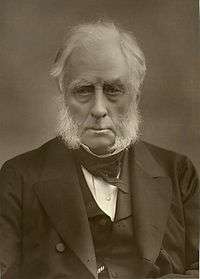William Cavendish, 7th Duke of Devonshire
| His Grace The Duke of Devonshire KG, PC | |
|---|---|
|
The Duke of Devonshire. | |
| Personal details | |
| Born | 27 April 1808 |
| Died | 21 December 1891 (aged 83) |
| Nationality | British |
| Spouse(s) |
Blanche Georgiana Howard (1812–1840) |
| Alma mater | Trinity College, Cambridge |
| Awards | Smith's Prize (1829) |
William Cavendish, 7th Duke of Devonshire KG, PC (27 April 1808 – 21 December 1891), styled as Lord Cavendish of Keighley between 1831 and 1834 and known as The Earl of Burlington between 1834 and 1858, was a British landowner, benefactor and politician.
Background and education
Cavendish was the son of William Cavendish, eldest son of George Cavendish, 1st Earl of Burlington, third son of William Cavendish, 4th Duke of Devonshire and Lady Charlotte Boyle, daughter of Richard Boyle, 3rd Earl of Burlington. His mother was the Honourable Louisa O'Callaghan (d. 1863), daughter of Cornelius O'Callaghan, 1st Baron Lismore. He was educated at Eton and the University of Cambridge (Trinity College), attaining the position of Second Wrangler and the Smith's Prize for mathematics.[1] He became known by the courtesy title Lord Cavendish of Keighley in 1831 when the earldom of Burlington was revived in favour of his grandfather.
Career
Cavendish was returned to parliament as the MP for Cambridge University in 1829, a seat he held until July 1831, when he was returned for Malton. He only sat for Malton until September of the same year and was out of the House of Commons until 1832, when he was returned for North Derbyshire. He succeeded his grandfather in the earldom of Burlington in 1834 and entered the House of Lords. In 1858 he also succeeded his cousin as Duke of Devonshire. He was Lord-Lieutenant of Lancashire from 1857 to 1891 and Lord-Lieutenant of Derbyshire from 1858 to 1891.
Devonshire was Chancellor of the University of London from 1836 to 1856, Chancellor of the University of Cambridge from 1861 to 1891, and Chancellor of the Victoria University from 1880 to 1891.[2] At Cambridge he endowed the Cavendish Professorship of Physics, and the building of the Cavendish Laboratory. He made vast (and ultimately unsuccessful) investments in heavy industry at Barrow-in-Furness, and had his nearby country house Holker Hall rebuilt in its present form after it was gutted by a fire in 1871. He was one of the original founders of the Royal Agricultural Society in 1839, and was president in 1870. On 26 July 1871, he was nominated a trustee of the British Museum.[3]
The 7th Duke inherited a considerable amount of property in Eastbourne from his grandfather, and from his wife Elizabeth Compton of Compton Place. He saw through the development of Eastbourne in the 19th century with its parks, baths and squares and is commemorated by a statue at the top of Devonshire Place.[4] The Duke also played a part in the foundation of Eastbourne College, the local independent school, by selling some of his land at a modest price to build the school on and commissioning respected architect Henry Currey to design the school chapel and College House (now the School House, a boarding facility).
Family
Devonshire married Blanche Georgiana Howard (11 January 1812 – 27 April 1840), daughter of George Howard, 6th Earl of Carlisle and Georgiana Cavendish, sister of the 6th Duke of Devonshire, known as the "Bachelor Duke", in 1829. Blanche was the Bachelor Duke's favourite niece, and his fondness for the young couple who were his heirs may have contributed to his decision not to marry himself. He commemorated Blanche with an inscription in the Painted Hall at Chatsworth, which states that he completed his reconstruction of the house in the year of his bereavement, 1840, and by Blanche's Urn at the top of the Long Walk in the garden.
The Duke's three surviving sons became distinguished politicians; the eldest, known after 1858 by the courtesy title Marquess of Hartington, led the Liberal Party and was asked three times to be Prime Minister by Queen Victoria; Lord Frederick Cavendish was briefly Chief Secretary for Ireland and was assassinated in 1882; Lord Edward Cavendish was MP for West Derbyshire. He also had one son, Lord William (8 October 1831 – 15 May 1834) who died as an infant, and a daughter, Lady Louisa Caroline (d. 21 September 1907), who married Admiral the Honourable Francis Egerton.
Ancestry
| Ancestors of William Cavendish, 7th Duke of Devonshire | |||||||||||||||||||||||||||||||||||||||||||||||||||||||||||||||||||||||||||||||||||||||||||||||||||||||||||||||||||||||||||||||||||||||||||||||||||||||||||||||||||||||||||||||||||||||||||||||||||||||||||||||||||||||||||||||||||||||||||||||||||||||||||||||||||||||||||||||||||||||||||||||||||||||||||||||||||||||||||||||||||||||||||||||||||||||||||||||||||||||||||||||||||||||||||||||||||||||||||||||||||||||||||||||||||||||||||||||||||||||||||||||||||||||||||||||||||||||||||||||||||||||||||||||||||||||
|---|---|---|---|---|---|---|---|---|---|---|---|---|---|---|---|---|---|---|---|---|---|---|---|---|---|---|---|---|---|---|---|---|---|---|---|---|---|---|---|---|---|---|---|---|---|---|---|---|---|---|---|---|---|---|---|---|---|---|---|---|---|---|---|---|---|---|---|---|---|---|---|---|---|---|---|---|---|---|---|---|---|---|---|---|---|---|---|---|---|---|---|---|---|---|---|---|---|---|---|---|---|---|---|---|---|---|---|---|---|---|---|---|---|---|---|---|---|---|---|---|---|---|---|---|---|---|---|---|---|---|---|---|---|---|---|---|---|---|---|---|---|---|---|---|---|---|---|---|---|---|---|---|---|---|---|---|---|---|---|---|---|---|---|---|---|---|---|---|---|---|---|---|---|---|---|---|---|---|---|---|---|---|---|---|---|---|---|---|---|---|---|---|---|---|---|---|---|---|---|---|---|---|---|---|---|---|---|---|---|---|---|---|---|---|---|---|---|---|---|---|---|---|---|---|---|---|---|---|---|---|---|---|---|---|---|---|---|---|---|---|---|---|---|---|---|---|---|---|---|---|---|---|---|---|---|---|---|---|---|---|---|---|---|---|---|---|---|---|---|---|---|---|---|---|---|---|---|---|---|---|---|---|---|---|---|---|---|---|---|---|---|---|---|---|---|---|---|---|---|---|---|---|---|---|---|---|---|---|---|---|---|---|---|---|---|---|---|---|---|---|---|---|---|---|---|---|---|---|---|---|---|---|---|---|---|---|---|---|---|---|---|---|---|---|---|---|---|---|---|---|---|---|---|---|---|---|---|---|---|---|---|---|---|---|---|---|---|---|---|---|---|---|---|---|---|---|---|---|---|---|---|---|---|---|---|---|---|---|---|---|---|---|---|---|---|---|---|---|---|---|---|---|---|---|---|---|---|---|---|---|---|---|---|---|---|---|---|---|---|---|---|---|---|---|---|---|---|---|---|---|---|---|---|---|---|---|---|---|---|---|---|---|---|---|---|---|---|---|---|---|---|---|---|---|---|---|---|---|---|---|---|---|---|---|---|---|---|---|---|---|---|---|---|---|---|---|---|---|---|---|---|---|---|---|---|---|---|---|---|---|---|---|---|---|---|---|---|---|---|---|---|---|---|
| |||||||||||||||||||||||||||||||||||||||||||||||||||||||||||||||||||||||||||||||||||||||||||||||||||||||||||||||||||||||||||||||||||||||||||||||||||||||||||||||||||||||||||||||||||||||||||||||||||||||||||||||||||||||||||||||||||||||||||||||||||||||||||||||||||||||||||||||||||||||||||||||||||||||||||||||||||||||||||||||||||||||||||||||||||||||||||||||||||||||||||||||||||||||||||||||||||||||||||||||||||||||||||||||||||||||||||||||||||||||||||||||||||||||||||||||||||||||||||||||||||||||||||||||||||||||
References
- ↑ "Cavendish, William (CVNS825W)". A Cambridge Alumni Database. University of Cambridge.
- ↑ "The Victoria University". Edinburgh Evening News. 15 July 1880. Retrieved 4 April 2016 – via British Newspaper Archive. (subscription required (help)).
- ↑
 This article incorporates text from a publication now in the public domain: Carlyle, Edward Irving (1901). "Cavendish, William (1808-1891)". In Sidney Lee. Dictionary of National Biography, 1901 supplement. London: Smith, Elder & Co.
This article incorporates text from a publication now in the public domain: Carlyle, Edward Irving (1901). "Cavendish, William (1808-1891)". In Sidney Lee. Dictionary of National Biography, 1901 supplement. London: Smith, Elder & Co. - ↑ Eastbourne Web – A short history of Eastbourne
External links
- Hansard 1803–2005: contributions in Parliament by The Duke of Devonshire
- "William Cavendish, 7th Duke of Devonshire". thePeerage.com.

